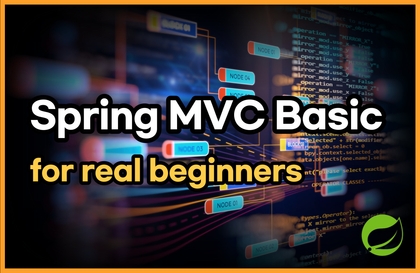
Spring MVC Basics for Non-Majors
admin0013
Through this lecture, even non-majors can fully understand the concepts and operating principles of the MVC module, which is the core of Spring.
Basic
Spring, MVC, Spring Boot
Through this lecture, even non-majors can fully understand the concept and operating principles of AOP (Aspect Oriented Programming), a core module of Spring.

Understanding the concepts and operating principles of Spring AOP
Understanding Spring AOP Terminology
Applying AOP settings in XML format
Applying AOP settings based on annotation
Who is this course right for?
Non-major graduates seeking employment as Java-based backend developers
A humanities/social sciences student who wants to become a Java-based backend developer
New employees who need to develop or operate Spring-based systems
Beginner developer who has completed learning Java programming
Need to know before starting?
Java Programming Language
SQL Basics (Understanding Basic CRUD Queries)
JDBC-based DB connection processing
Spring IoC
1,379
Learners
120
Reviews
13
Answers
4.9
Rating
21
Courses

IT 기업 교육 현장에서 20년 넘게 다양한 학습자들과 호흡하며 IT 관련 교육을 진행한 분야별 최고의 쌤들(SSAMZ)이 모여서 설립한 회사입니다.
쌤즈는 온라인 강의뿐만 아니라 기업 맞춤형 대면 교육을 통한 코칭, 멘토링을 제공하여 소프트웨어 전문가를 꿈꾸는 학생에서부터 현업 개발자, 엔지니어들을 양성하는데 힘쓰고 있습니다.

좋은 강의는 강사의 전문성 + 지식 컨텐츠 + 전달 능력에 의해 결정됩니다. 쌤즈는 최고 경력의 전문 강사들의 고품질 컨텐츠를 바탕으로 수강생 눈높이에서 이해하기 쉽도록 전달하는 교육을 지향합니다.
교육 문의 : admin@ssamz.com
All
42 lectures ∙ (5hr 43min)
Course Materials:
All
4 reviews
5.0
4 reviews
Reviews 20
∙
Average Rating 5.0
5
After completing IoC once, I am taking the AOP course. The lecture content is easy to understand and follow along, and it is good to listen to it!! I also liked the part where the teacher briefly refreshes the mood by saying, "Look at the screen in the middle" or "I will take a break." I want to complete the AOP course soon too!! Thank you.
This is instructor Chae Gyu-tae. First of all, thank you for your valuable course review. I will try to make the lectures easier and more useful in the future.
Reviews 5
∙
Average Rating 5.0
Reviews 15
∙
Average Rating 5.0
Reviews 3
∙
Average Rating 5.0
Limited time deal ends in 8 days
$46,200.00
30%
$51.70
Check out other courses by the instructor!
Explore other courses in the same field!